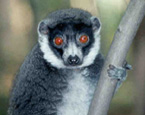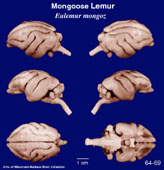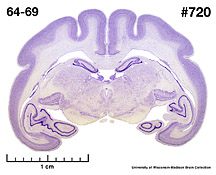|
Mongoose
Lemur
(Eulemur mongoz) #64-69 |
||||
|
|
Physical
characteristics and distribution
|
|
Mongoose
Lemurs are dull brown with white cheeks. The head and body
length is 300-450 mm with tails about the same length. They
have soft fur with a pronounced ruff around the neck and ears.
They are arboreal, using all fours to run and leap among branches.
They are mostly diurnal but some specific groups are nocturnal
in Madagascar and Comoros. Some permanently bonded pairs have been observed with no more than two young. Vocalizations are well developed with greeting calls, territorial expression, threats, and alarms. Mongoose lemurs mate from April to June with gestation of about 4.5 months. Births occur just before the rainy season. Usually there is one young, but sometimes twins are born. The infant clings to the mother's underside the first four weeks and then move to a spot on her back. They are found in NW Madagascar, between Majunja and Betsiboka; Anjouan, and Moheli (Comoro Isls). |
|
Description
of the brain
|
|
Animal
source and preparation
|
|
All
specimens collected followed the same preparation
and histological procedure.
|
Other Related Resources (websites and publications)
List of Specimens | Explore Collections | Brain Sections | Brain Evolution | Brain Development | Brain Circuitry | Brain Functions | Location and Use | Related Web Sites | Contact Us | Search MSU Database | Personnel | Home



